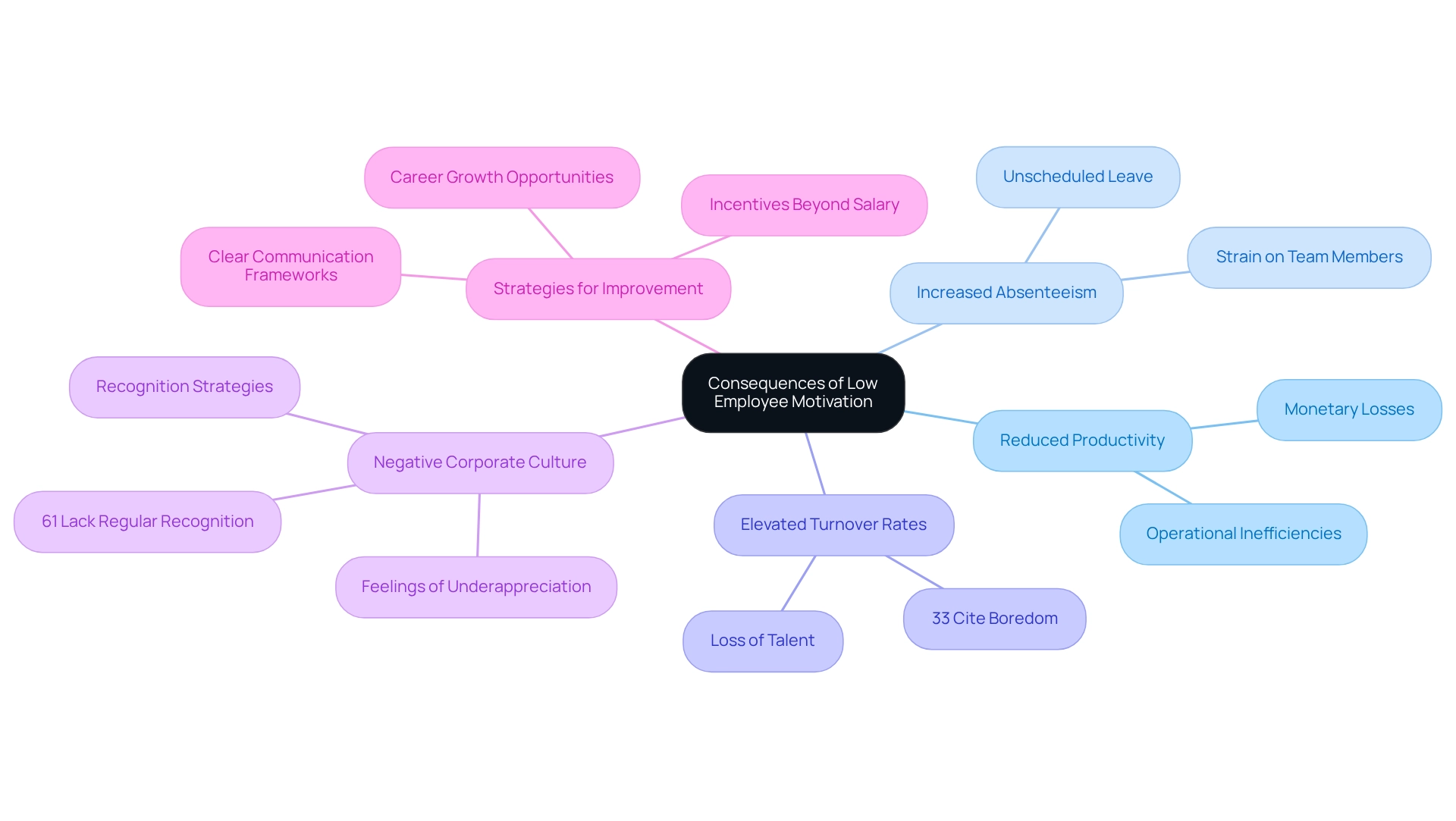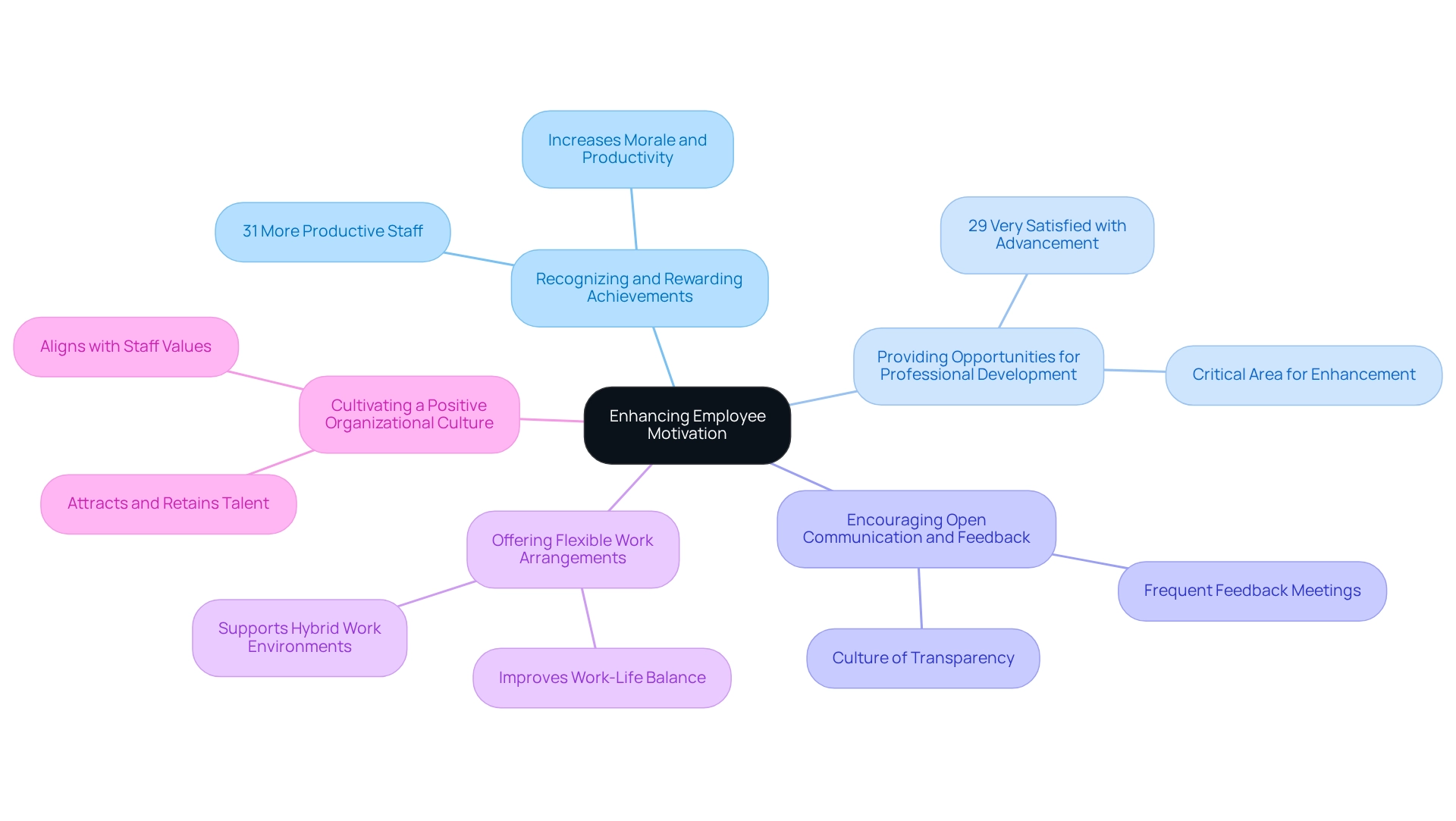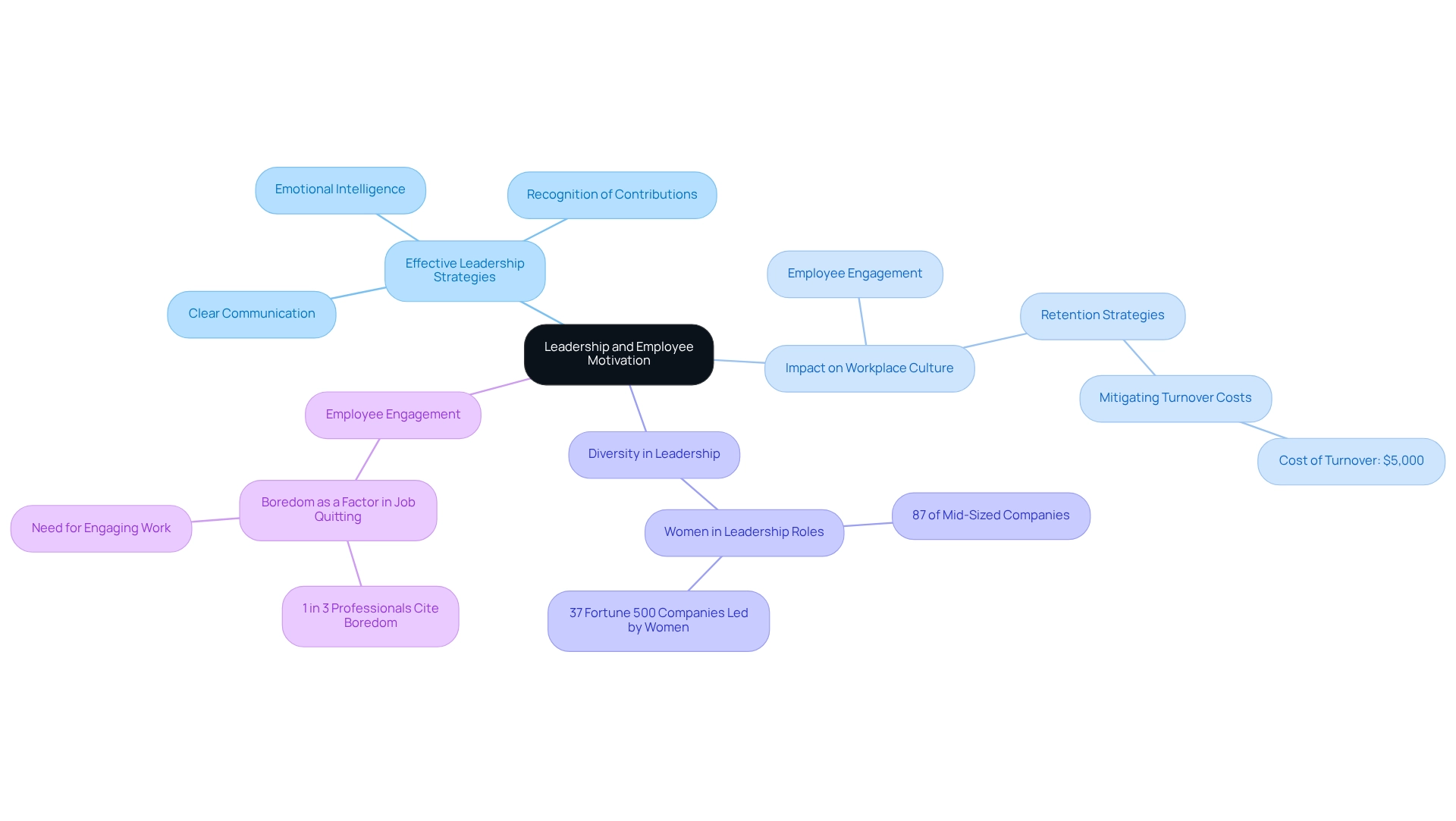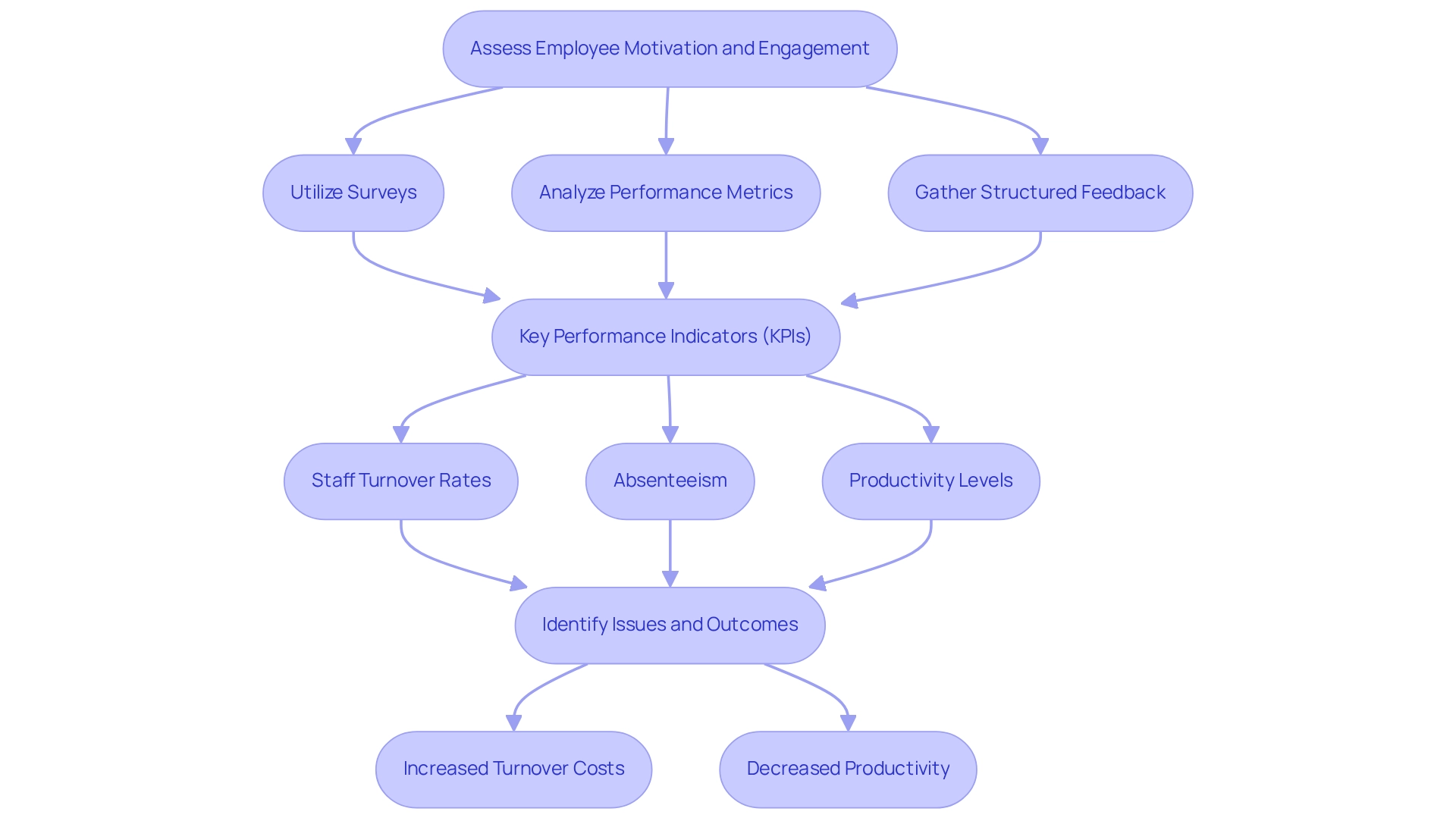Overview
The article addresses the critical issue of employee motivation in the workplace and outlines how HR professionals can effectively understand and overcome this challenge through strategic engagement initiatives. Fostering employee motivation is not merely beneficial; it is essential for enhancing productivity and retention. Evidence demonstrates that organizations exhibiting high levels of employee engagement enjoy superior performance metrics, which include significantly reduced turnover rates and increased profitability. The implications are clear: prioritizing engagement strategies is a decisive factor in organizational success.
Key Highlights:
- Employee engagement is crucial for productivity, job satisfaction, and retention, with motivated staff leading to better outcomes.
- Organizations prioritizing employee engagement see improved performance metrics, including reduced turnover rates.
- Gallup study emphasizes the importance of meaningful manager-employee interactions for maintaining engagement.
- 33% of professionals cite boredom as a major reason for quitting, highlighting the need for proactive engagement strategies.
- Low employee motivation can lead to decreased productivity, increased absenteeism, and higher turnover rates.
- Recognition programs can boost staff morale and productivity, with engaged employees being 31% more productive.
- Effective communication, career development opportunities, and a positive workplace culture are key strategies to enhance motivation.
- Leadership plays a vital role in shaping workplace culture and motivating employees through recognition and clear communication.
- Regular surveys and feedback mechanisms are essential for measuring motivation levels and adapting strategies accordingly.
- HR professionals must address common causes of demotivation to foster a more engaged workforce and drive organizational success.
Introduction
In the dynamic landscape of modern workplaces, employee motivation is a cornerstone of organizational success. It transcends mere buzzword status; it is a critical factor influencing productivity, job satisfaction, and retention rates. Motivated employees engage deeply with their tasks, resulting in higher quality outputs and a vibrant workplace culture.
Yet, many organizations grapple with maintaining motivation amidst challenges such as ineffective feedback and a lack of recognition. Research underscores the profound impact of motivation on performance metrics, including profitability and turnover rates.
Therefore, it is imperative for HR professionals to implement effective strategies that foster an engaged and motivated workforce. This article delves into the intricacies of employee motivation, exploring its importance, the consequences of neglecting it, and actionable strategies organizations can adopt to cultivate a thriving environment where employees feel valued and inspired.
The Importance of Employee Motivation in the Workplace
Employee engagement stands as a pivotal factor influencing productivity, job satisfaction, and retention within organizations. When staff members are motivated, they are more inclined to immerse themselves in their tasks, resulting in enhanced quality outcomes and fostering a positive workplace culture. Research indicates that organizations prioritizing employee engagement witness substantial improvements in performance metrics, notably a significant decrease in turnover rates.
For instance, a Gallup study underscores that meaningful interactions between managers and employees are essential for maintaining clarity of expectations and bolstering engagement. Yet, many employees report a decline in receiving such feedback, which can lead to diminished motivation in the workplace. This drop in meaningful feedback is alarming, particularly in light of the fact that the margin of sampling error for Q4 surveys is ±1.0 percentage points at the 95% confidence level, affirming the reliability of these findings.
The influence of motivation, particularly in the context of waning enthusiasm at work, extends beyond immediate productivity; it significantly impacts job satisfaction and retention rates. Engaged employees frequently exhibit heightened commitment to their organizations, which translates into reduced turnover rates. Current statistics reveal that companies with elevated levels of employee engagement can experience up to 21% greater profitability, highlighting the necessity of cultivating a motivated workforce.
To effectively invigorate enthusiasm, organizations can adopt successful strategies such as:
- Recognizing individual contributions
- Facilitating professional development opportunities
- Ensuring consistent, strengths-based feedback
These methods not only bolster morale but also align individual aspirations with organizational objectives, creating a mutually beneficial environment. As Jack, an Art and VFX Director, articulates, “My work can contribute to stress, and it can also contribute to a sense of satisfaction. And they balance each other out to the point that I don’t feel like I need to make a change.”
In conclusion, the importance of staff encouragement in addressing the decline of motivation in the workplace cannot be overstated. It is a critical element that shapes productivity, job satisfaction, and retention rates, making it an essential focus for HR professionals dedicated to nurturing a thriving organizational environment. For further insights, readers are encouraged to download the Key Insights or Full Report from Gallup’s State of the Global Workplace: 2024 after completing a form.
Consequences of Low Employee Motivation
Reduced staff enthusiasm can initiate a series of adverse results that greatly affect organizational well-being. Among the most pressing consequences are decreased productivity, increased absenteeism, and elevated turnover rates. When motivation wanes among staff members, job performance frequently falters, leading to a decline in team spirit and overall efficiency within the company.
This situation is especially troubling considering that 33% of professionals cite boredom as a primary factor for quitting their positions. This statistic underscores the urgency for HR personnel to address engagement issues proactively.
The consequences of low engagement extend beyond individual performance; they can significantly influence the overall corporate culture. A negative working environment can sap motivation, demotivating even previously engaged staff and weakening the very fabric of the organization. For instance, a study revealed that 61% of the workforce does not receive regular recognition, fostering feelings of underappreciation and disengagement.
Implementing regular acknowledgment strategies has been shown to enhance staff enthusiasm and retention, highlighting the necessity for organizations to cultivate a supportive atmosphere.
Furthermore, the effects of low enthusiasm manifest in practical scenarios where reduced productivity translates into monetary losses and operational inefficiencies. Companies that neglect to create a motivating environment may find themselves grappling with high absenteeism rates, as unmotivated employees are more likely to take unscheduled leave. This not only disrupts workflow but also places additional strain on remaining team members, further exacerbating the issue—a direct consequence of diminished motivation at the workplace. To combat these challenges, organizations must prioritize strategies that foster motivation.
Establishing clear communication frameworks, providing opportunities for career growth, and creating incentives beyond salary are vital measures in building an inspiring workplace. Moreover, to ensure staff remain motivated and achieve their full potential, organizations should cultivate a supportive working environment. By understanding the complex effects of low staff motivation, HR specialists can implement targeted interventions that enhance engagement and drive organizational success.
Common Causes of Employee Demotivation
Employee demotivation can stem from several key factors, including:
- A lack of recognition
- Ineffective management practices
- Insufficient career development opportunities
- A toxic work environment
- A general lack of motivation in the workplace
Research indicates that job insecurity and limited autonomy also play significant roles in fostering disengagement among workers. To effectively address these issues, HR professionals must actively seek input from staff and conduct engagement surveys.
This proactive strategy empowers organizations to identify specific reasons for demotivation and implement focused measures that can enhance overall workplace morale and productivity.
For instance, companies that prioritize recognition programs often witness a marked improvement in staff motivation. A study revealed that organizations with strong recognition initiatives experience a 27% increase in staff engagement compared to those that do not. Furthermore, inadequate management practices can lead to a disengaged workforce, as demonstrated by case studies emphasizing the connection between leadership development and worker satisfaction.
Effective leadership training has been shown to enhance knowledge and skills by 25%, directly impacting staff motivation and retention. The case study titled ‘Benefits of Leadership Development for Businesses’ outlines the advantages of implementing robust leadership development programs, including increased workforce productivity and decreased turnover.
As we approach 2025, the landscape of worker engagement continues to evolve, with a persistent lack of motivation in the workplace being a consistent cause of demotivation. HR professionals must remain vigilant in recognizing these issues and cultivating an atmosphere that promotes acknowledgment, effective management, and career advancement to combat disengagement and improve overall staff satisfaction. Moreover, fostering staff engagement and involvement can enhance focus and reduce distractions, thereby contributing to a productive work environment.
Creative strategies, such as Wildgoose’s new remote team-building offerings, can also strengthen worker connections, which are vital for sustaining enthusiasm in a remote work setting.
Effective Strategies to Enhance Employee Motivation
To effectively enhance employee motivation, HR professionals can adopt a variety of impactful strategies:
- Recognizing and Rewarding Achievements: Acknowledging staff accomplishments fosters a sense of pride and belonging. Organizations that implement recognition programs experience a notable increase in morale and productivity, with content staff being 31% more productive. This underscores the direct link between recognition and staff performance.
- Providing Opportunities for Professional Development: Investing in individuals’ growth through training and career advancement options is crucial. Significantly, merely 29% of staff indicate being very satisfied with their career advancement opportunities, highlighting a critical area for enhancement that can lead to greater job satisfaction and motivation. Addressing this gap can significantly enhance workforce engagement and reduce the lack of motivation in the workplace.
- Encouraging Open Communication and Feedback: Creating a culture of transparency and support motivates staff to express their ideas and concerns. Frequent feedback meetings can assist staff in feeling appreciated and involved, ultimately boosting their drive.
- Offering Flexible Work Arrangements: Flexible work arrangements can significantly improve work-life balance, which is essential for addressing the lack of motivation in the workplace. Organizations that adapt their management practices to support hybrid work environments, as discussed in the case study ‘Addressing Hybrid Work,’ have reported improved staff engagement and performance across diverse work settings.
- Cultivating a Positive Organizational Culture: Aligning the workplace culture with staff values and goals is vital. A positive culture not only attracts talent but also retains it, as individuals are more likely to thrive in a setting that aligns with their personal and career aspirations.
By implementing these strategies, HR professionals can create a motivating workplace that not only acknowledges and rewards achievements but also fosters individuals’ growth and well-being. As Eric Eddy observed, the capacity to provide exceptional candidates swiftly and effectively demonstrates the success of tailored methods in enhancing workforce enthusiasm and contentment.
The Role of Leadership in Employee Motivation
Leadership is essential to staff enthusiasm, shaping workplace culture and preventing a lack of motivation, which directly affects overall engagement. Effective leaders motivate their teams through clear communication, recognition of individual contributions, and by exemplifying the behaviors they wish to instill in their staff. This methodology fosters an environment where employees feel valued and empowered, significantly enhancing their motivation levels.
HR specialists must prioritize leadership development initiatives that focus on motivational strategies and emotional intelligence. Such programs not only enhance leaders’ capabilities to engage their teams but also align with the increasing trend of women in leadership roles. Indeed, 87% of mid-sized companies globally now have at least one woman in a senior management position, illustrating this shift. This is further evidenced by the fact that 37 Fortune 500 companies are led by women, showcasing the positive influence diverse leadership can exert on workplace culture.
Moreover, a compelling case study reveals that one in three professionals cites boredom as a primary reason for leaving their jobs. This statistic underscores the pressing need for leaders to provide engaging work and a culture that resonates with staff values. By fostering a stimulating environment, leaders can mitigate turnover costs, which average over $5,000 each time a staff member departs due to hiring and settling expenses. This highlights the essential role of leadership in not only inspiring staff but also in addressing workplace motivation to cultivate an environment that retains talent.
As Thomas Griffin, a seasoned business leader, asserts, “When you can acknowledge your own strengths, pitfalls, and purpose — and learn to wield them accordingly, you’re one step closer to becoming a great leader.” This perspective underscores the importance of self-awareness in leadership, a crucial element for inspiring and motivating teams.
Looking ahead to 2025, the role of leadership in worker encouragement will continue to evolve, necessitating an emphasis on innovative leadership styles that inspire and engage. Effective leaders not only motivate their teams but also play a pivotal role in shaping a positive workplace culture that enhances staff engagement and retention.
Measuring Employee Motivation and Engagement
To effectively assess staff enthusiasm and involvement, HR professionals can utilize a range of techniques, including surveys, performance metrics, and structured feedback mechanisms. Key performance indicators (KPIs) like staff turnover rates, absenteeism, and productivity levels serve as essential metrics that provide valuable insights into the lack of motivation at the workplace within a company. For instance, studies show that companies incur losses exceeding $5,000 whenever a staff member leaves, highlighting the financial consequences of turnover and the importance of grasping workforce sentiment.
Frequent pulse surveys are especially useful in monitoring changes in workforce sentiment. They enable HR teams to pinpoint areas that require enhancement. Research indicates that the lack of motivation at the workplace, often due to feeling unappreciated, makes workers twice as likely to contemplate departing from their positions. This emphasizes the crucial connection between acknowledgment and retention. By prioritizing acknowledgment through targeted surveys, organizations can significantly reduce turnover rates and cultivate a more stable workplace environment.
Moreover, expert opinions suggest that consulting firms like Gallup and BCG have streamlined the process of assessing engagement to focus on fewer than ten critical questions. Heidi Pond emphasizes this approach, stating that it not only simplifies the measurement process but also enhances the accuracy of the insights gathered. Organizations that proactively use staff surveys to track engagement levels can adjust their approaches to more effectively meet workforce needs, ultimately resulting in enhanced performance and satisfaction throughout.
Furthermore, a recent report on the state of workplace connection in 2025 reveals important data on staff turnover and retention, providing a timely perspective that underscores the need for effective measurement strategies.
Key Takeaways for HR Professionals
HR professionals play a crucial role in fostering staff enthusiasm, which is vital for organizational success. Grasping the importance of drive is the initial phase; a lack of motivation in the workplace can lead to disengagement, a concerning issue that impacts 70% of workers worldwide. This disengagement costs the global economy approximately $8.9 trillion, emphasizing the urgent need for effective strategies to enhance drive.
Significantly, only 22% of organizations understand what is leading to disengagement among their staff, highlighting a notable gap in awareness that HR leaders must tackle.
Recognizing the common causes of a lack of motivation in the workplace—such as lack of recognition, unclear expectations, and insufficient growth opportunities—enables HR leaders to proactively address these issues. Leadership plays a vital role in fostering a motivating environment, where open communication and support are prioritized. Furthermore, measuring motivation levels through regular surveys and feedback mechanisms is crucial for continuous improvement and adaptation of strategies.
To enhance staff engagement, HR professionals can implement successful strategies such as:
- Personalized recognition programs
- Career development initiatives
- Team-building activities that align with individuals’ values and aspirations
For instance, groups that have implemented customized recognition programs have observed a significant rise in staff satisfaction and productivity.
Case studies, including the one titled “Current State of Workforce Engagement,” reveal that companies concentrating on workforce engagement have significantly improved their retention rates and overall performance. By comprehending and tackling the elements that affect drive, HR professionals can mitigate the lack of motivation in the workplace and foster a more engaged workforce, ultimately steering the organization toward greater success. Key takeaways for HR include the necessity of measuring engagement metrics, recognizing the significance of workforce motivation, and implementing effective engagement strategies tailored to their unique workplace culture.
As J.R. Johnivan, a Business and HR Tech Journalist, emphasizes, understanding employee motivation is crucial for fostering a productive work environment.
Conclusion
Employee motivation stands as a critical pillar for organizational success, influencing productivity, job satisfaction, and retention rates. The importance of fostering an engaged workforce cannot be overstated; motivated employees contribute to a vibrant workplace culture and enhanced performance metrics. Organizations that prioritize employee motivation often experience lower turnover rates and increased profitability, underscoring the tangible benefits of investing in a motivated workforce.
Neglecting employee motivation, conversely, can lead to a cascade of negative outcomes, including decreased productivity and increased absenteeism. Common causes of demotivation—such as lack of recognition and ineffective management practices—must be actively addressed by HR professionals to prevent disengagement. Implementing effective strategies, such as recognizing achievements, providing professional development opportunities, and fostering open communication, can significantly enhance employee motivation and create a more positive organizational culture.
Leadership plays an essential role in shaping motivation levels within teams. Effective leaders inspire their employees by recognizing their contributions and nurturing a culture of appreciation and support. Furthermore, measuring employee motivation through surveys and performance metrics allows organizations to adapt their strategies and respond to employee needs proactively.
In summary, prioritizing employee motivation is not merely beneficial; it is essential for achieving long-term organizational success. By understanding its significance and implementing targeted strategies, HR professionals can cultivate an environment where employees feel valued, engaged, and inspired to contribute their best efforts. The time for organizations to act and elevate employee motivation is now, as it ultimately drives not only individual satisfaction but also collective success.
Frequently Asked Questions
Why is employee engagement important for organizations?
Employee engagement is crucial because it influences productivity, job satisfaction, and retention. Motivated staff are more likely to immerse themselves in their tasks, leading to better outcomes and a positive workplace culture.
What are the consequences of reduced employee motivation?
Reduced motivation can lead to decreased productivity, increased absenteeism, and higher turnover rates. It can also negatively impact team spirit and overall efficiency within the organization.
What percentage of professionals cite boredom as a reason for quitting their jobs?
33% of professionals report boredom as a primary factor for leaving their positions.
How does low employee engagement affect corporate culture?
Low engagement can create a negative working environment, demotivating even previously engaged staff and weakening the organization. A lack of regular recognition contributes to feelings of underappreciation and disengagement.
What strategies can organizations implement to enhance employee motivation?
Organizations can enhance motivation by recognizing individual contributions, facilitating professional development opportunities, ensuring consistent strengths-based feedback, and establishing clear communication frameworks.
What impact does high employee engagement have on profitability?
Companies with high levels of employee engagement can experience up to 21% greater profitability, highlighting the importance of a motivated workforce.
What is the role of feedback in maintaining employee engagement?
Meaningful interactions and feedback between managers and employees are essential for maintaining clarity of expectations and boosting engagement. A decline in such feedback can lead to diminished motivation.
What are some practical measures organizations can take to combat low enthusiasm?
Organizations should prioritize clear communication, provide career growth opportunities, and create incentives beyond salary to build an inspiring workplace.
How can regular acknowledgment strategies affect employee retention?
Implementing regular acknowledgment strategies can enhance staff enthusiasm and retention, fostering a supportive atmosphere that values contributions.
What is the significance of cultivating a supportive working environment?
A supportive working environment helps ensure that staff remain motivated and can achieve their full potential, ultimately driving organizational success.









